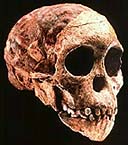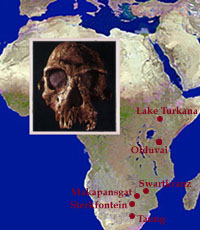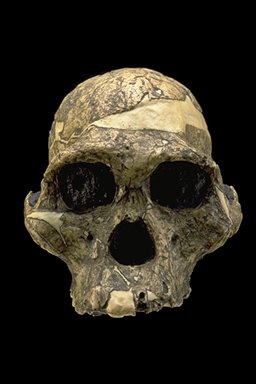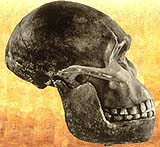Hominid Species Time Line
Page 13
A. africanus
3.0-2.4 million years ago
 The first discovery of an early hominid species in Africa was by Raymond Dart, pictured at left, who found this well-preserved skull of a juvenile in South Africa in 1924. His discovery led to an intense focus on Africa as the probable site of human origins, as Charles Darwin had predicted.
The first discovery of an early hominid species in Africa was by Raymond Dart, pictured at left, who found this well-preserved skull of a juvenile in South Africa in 1924. His discovery led to an intense focus on Africa as the probable site of human origins, as Charles Darwin had predicted.
 Dart named this newly discovered species Australopithecus africanus, or "Southern Ape of Africa." This specimen of a child, often called the "Taung Baby," after the site in which it was discovered, preserves remarkable physical details. Some of the permanent teeth are not yet descended, suggesting an age of about 8 years at the time of death. An imprint of the brain case is preserved in limestone, and the foramen magnum, the opening in the skull through which the spinal cord attaches to the brain, indicates that this creature walked upright like human beings. A cast of the brain was somehow preserved in the fossilization process.
Dart named this newly discovered species Australopithecus africanus, or "Southern Ape of Africa." This specimen of a child, often called the "Taung Baby," after the site in which it was discovered, preserves remarkable physical details. Some of the permanent teeth are not yet descended, suggesting an age of about 8 years at the time of death. An imprint of the brain case is preserved in limestone, and the foramen magnum, the opening in the skull through which the spinal cord attaches to the brain, indicates that this creature walked upright like human beings. A cast of the brain was somehow preserved in the fossilization process.
Australopithecus africanus is both larger in body size and brain (420-500 cc) than the earlier A. afarensis, but the configuration of its brain is still more ape-like than human and not organized for speech in the way our brains are.  The teeth are larger than ours, but resemble ours in shape and dental enamel more than they do those of chimps. This species, which is represented by several well-preserved skulls and numerous fragmentary remains of individuals, was a contemporary of early human species—and perhaps competed with early humans.
The teeth are larger than ours, but resemble ours in shape and dental enamel more than they do those of chimps. This species, which is represented by several well-preserved skulls and numerous fragmentary remains of individuals, was a contemporary of early human species—and perhaps competed with early humans.
The artist's reconstruction of A. africanus above right shows the species' erect posture and bipedalism, and it places tools (weapons) of wood and bone in this male individual's hands. Primitive stone choppers and flakes have been discovered at sites in regions where this species lived which are potassium-argon dated to 3.1 and 2.5 million years ago. However, no stone tools have been found directly associated with this species.

The remains of Australopithecus africanus have been found widely distributed in eastern Africa along the Rift Valley and from northern Ethiopia to central South Africa. Recently, a discovery was made of an australopithecine in central Africa. Closely related species and subspecies of australopithecines survived to approximately l million years ago.
Some scholars regarded—still regard—A. africanus as a direct ancestor of human beings, but the prevailing view currently is that this species represents a related or branch line of hominids—"cousins" of ancestral humans, who evolved, thrived for a time, and then disappeared.
Below is a remarkably complete skull, STS 5, of an adult female:

 The first discovery of an early hominid species in Africa was by Raymond Dart, pictured at left, who found this well-preserved skull of a juvenile in South Africa in 1924. His discovery led to an intense focus on Africa as the probable site of human origins, as Charles Darwin had predicted.
The first discovery of an early hominid species in Africa was by Raymond Dart, pictured at left, who found this well-preserved skull of a juvenile in South Africa in 1924. His discovery led to an intense focus on Africa as the probable site of human origins, as Charles Darwin had predicted. Dart named this newly discovered species Australopithecus africanus, or "Southern Ape of Africa." This specimen of a child, often called the "Taung Baby," after the site in which it was discovered, preserves remarkable physical details. Some of the permanent teeth are not yet descended, suggesting an age of about 8 years at the time of death. An imprint of the brain case is preserved in limestone, and the foramen magnum, the opening in the skull through which the spinal cord attaches to the brain, indicates that this creature walked upright like human beings. A cast of the brain was somehow preserved in the fossilization process.
Dart named this newly discovered species Australopithecus africanus, or "Southern Ape of Africa." This specimen of a child, often called the "Taung Baby," after the site in which it was discovered, preserves remarkable physical details. Some of the permanent teeth are not yet descended, suggesting an age of about 8 years at the time of death. An imprint of the brain case is preserved in limestone, and the foramen magnum, the opening in the skull through which the spinal cord attaches to the brain, indicates that this creature walked upright like human beings. A cast of the brain was somehow preserved in the fossilization process.
 The teeth are larger than ours, but resemble ours in shape and dental enamel more than they do those of chimps. This species, which is represented by several well-preserved skulls and numerous fragmentary remains of individuals, was a contemporary of early human species—and perhaps competed with early humans.
The teeth are larger than ours, but resemble ours in shape and dental enamel more than they do those of chimps. This species, which is represented by several well-preserved skulls and numerous fragmentary remains of individuals, was a contemporary of early human species—and perhaps competed with early humans.


